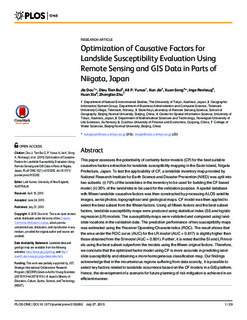| dc.description.abstract | This paper assesses the potentiality of certainty factor models (CF) for the best suitable causative factors extraction for landslide susceptibility mapping in the Sado Island, Niigata
Prefecture, Japan. To test the applicability of CF, a landslide inventory map provided by National Research Institute for Earth Science and Disaster Prevention (NIED) was split into two subsets: (i) 70% of the landslides in the inventory to be used for building the CF based model; (ii) 30% of the landslides to be used for the validation purpose. A spatial database with fifteen landslide causative factors was then constructed by processing ALOS satellite images, aerial photos, topographical and geological maps. CF model was then applied to select the best subset from the fifteen factors. Using all fifteen factors and the best subset factors, landslide susceptibility maps were produced using statistical index (SI) and logistic regression (LR) models. The susceptibility maps were validated and compared using landslide locations in the validation data. The prediction performance of two susceptibility maps was estimated using the Receiver Operating Characteristics (ROC). The result shows that the area under the ROC curve (AUC) for the LR model (AUC = 0.817) is slightly higher than those obtained from the SI model (AUC = 0.801). Further, it is noted that the SI and LR models using the best subset outperform the models using the fifteen original factors. Therefore, we conclude that the optimized factor model using CF is more accurate in predicting landslide susceptibility and obtaining a more homogeneous classification map. Our findings acknowledge that in the mountainous regions suffering from data scarcity, it is possible to select key factors related to landslide occurrence based on the CF models in a GIS platform. Hence, the development of a scenario for future planning of risk mitigation is achieved in an efficient manner | nb_NO |

